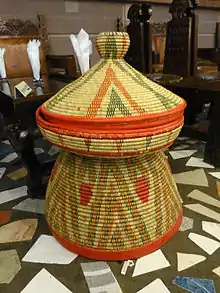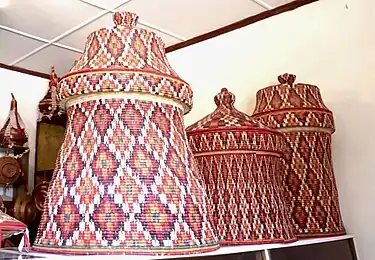
Mesob (Amharic: መሶብ) or Harar Mesob is a Harari basket used for storing injera, an Ethiopian and Eritrean flatbread.[1][2] It is widely depicted as a cultural symbol for Ethiopia and Eritrea made from locally grown and partially dyed grass and palm leaves known for strength and durability.[3][4]
History
In a certain form Mesob was identified in Abyssinia as early as the sixteenth century as reported by Portuguese explorer Francisco Álvares however the most prominent Mesob is of Harar origin.[5] In the mid 1970s Amharas began recruiting Harari artisans to develop a particular Mesob which incorporated Abyssinian and Harari designs, this variety would dominate Mesob productions in Ethiopia.[6]

In popular culture
Mesob is depicted in 10 birr note as a woman hold to sew it. Mesob is used for death ceremony to support family of the deceased person and widely viewed as a symbolical representation of Ethiopian and Eritrean culture and their cuisine.[4]
References
- ↑ Shinn, David (29 March 2004). Historical Dictionary of Ethiopia. Scarecrow Press. p. 198. ISBN 9780810865662.
- ↑ Berg, Elizabeth (2000). Ethiopia. G. Stevens. p. 33. ISBN 9780836823240.
- ↑ "Traditional Injera Mesob Ethiopian Eritrean Household - The Habesha Web". Retrieved 2022-09-13.
- 1 2 Neela, Satheesh; Fanta, Solomon Workneh (13 September 2022). "Injera (An Ethnic, Traditional Staple Food of Ethiopia): A review on Traditional Practice to Scientific Developments" (PDF). Journal of Ethnic Foods. 7. doi:10.1186/s42779-020-00069-x. S2CID 221824144.
- ↑ Basketry. Encyclopedia Aethiopica.
- ↑ Tarsitani, Belle. Revered vessels: custom and innovation in Harari basketry. MIT Press Journals. p. 73.